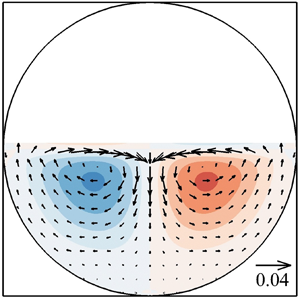Crossref Citations
This article has been cited by the following publications. This list is generated based on data provided by
Crossref.
Liu, Y.
Reible, D.
and
Hussain, F.
2022.
Roles of Tidal Cycling, Hyporheic Exchange and Bioirrigation on Metal Release From Estuary Sediments.
Water Resources Research,
Vol. 58,
Issue. 4,
Zhao, Hanqing
Xu, Yun
Lu, Yang
Lu, Shanshan
Dai, Jie
and
Meng, Dinghua
2022.
Numerical Study of Vertical Slot Fishway Flow with Supplementary Cylinders.
Water,
Vol. 14,
Issue. 11,
p.
1772.
Kadia, Subhojit
Rüther, Nils
Albayrak, Ismail
and
Pummer, Elena
2022.
Reynolds stress modeling of supercritical narrow channel flows using OpenFOAM: Secondary currents and turbulent flow characteristics.
Physics of Fluids,
Vol. 34,
Issue. 12,
Yu, Ming
Fu, Yalu
Liu, Pengxin
Tang, Zhigong
Yuan, Xianxu
and
Xu, Chunxiao
2022.
Hybrid numerical method for wall-resolved large-eddy simulations of compressible wall-bounded turbulence.
Acta Mechanica Sinica,
Vol. 38,
Issue. 9,
Yu, Ming
Modesti, Davide
and
Pirozzoli, Sergio
2023.
Direct numerical simulation of flow in open rectangular ducts.
Journal of Fluid Mechanics,
Vol. 977,
Issue. ,
Ortiz-Vidal, L. Enrique
and
Fiorot, Guilherme H.
2023.
Non-unique solutions for flow depth and velocity estimations in free-surface annular-channel for single-phase viscous flows.
Geoenergy Science and Engineering,
Vol. 227,
Issue. ,
p.
211818.
Luo, Qianyu
Stoesser, Thorsten
Cameron, Stuart
Nikora, Vladimir
Zampiron, Andrea
and
Patella, Wada
2023.
Meandering of instantaneous large-scale structures in open-channel flow over longitudinal ridges.
Environmental Fluid Mechanics,
Vol. 23,
Issue. 4,
p.
829.
Guo, Xingsen
Luo, Qianyu
Stoesser, Thorsten
Hajaali, Arthur
and
Liu, Xiaolei
2023.
Evolution of high-density submarine turbidity current and its interaction with a pair of parallel suspended pipes.
Physics of Fluids,
Vol. 35,
Issue. 8,
Luo, Qianyu
Stoesser, Thorsten
Jalalabadi, Razieh
and
Xie, Zhihua
2023.
Hydrodynamics and turbulence of free-surface flow over a backward-facing step.
Journal of Hydraulic Research,
Vol. 61,
Issue. 5,
p.
611.
Alzabari, Fawaz
Wilson, Catherine A.M.E.
and
Ouro, Pablo
2023.
Unsteady vortex shedding dynamics behind a circular cylinder in very shallow free-surface flows.
Computers & Fluids,
Vol. 260,
Issue. ,
p.
105918.
Chen, Zonghong
He, Guojian
Fang, Hongwei
Liu, Yan
and
Dey, Subhasish
2024.
Influence of Bioroughness Density on Turbulence Characteristics in Open-Channel Flows.
Journal of Hydraulic Engineering,
Vol. 150,
Issue. 4,
Liu, Yan
Tang, Zhengdao
Huang, Lei
Stoesser, Thorsten
and
Fang, Hongwei
2024.
On the role of the Froude number on flow, turbulence, and hyporheic exchange in open-channel flow through boulder arrays.
Physics of Fluids,
Vol. 36,
Issue. 9,
Ouro, Pablo
Mullings, Hannah
Christou, Aristos
Draycott, Samuel
and
Stallard, Tim
2024.
Wake characteristics behind a tidal turbine with surface waves in turbulent flow analyzed with large-eddy simulation.
Physical Review Fluids,
Vol. 9,
Issue. 3,
Wang, Zhili
Liu, Shangwu
Lu, Shengjie
Xian, Ruisi
and
Li, Danxun
2024.
Characteristics of very-large-scale motions in natural rivers based on large eddy simulation.
AIP Advances,
Vol. 14,
Issue. 5,
Li, Zhiwei
Wang, Bing
Wang, Feifei
Sun, Bin
and
Li, Liutao
2024.
Flow dynamics and turbulent coherent structures around sediment reduction plates of a sewer system.
Journal of Environmental Management,
Vol. 366,
Issue. ,
p.
121594.
Kadia, Subhojit
Lia, Leif
Albayrak, Ismail
and
Pummer, Elena
2024.
The effect of cross-sectional geometry on the high-speed narrow open channel flows: An updated Reynolds stress model study.
Computers & Fluids,
Vol. 271,
Issue. ,
p.
106184.
Zhdanov, Oleksandr
Jelly, Thomas O.
and
Busse, Angela
2024.
Influence of Ridge Spacing, Ridge Width, and Reynolds Number on Secondary Currents in Turbulent Channel Flow Over Triangular Ridges.
Flow, Turbulence and Combustion,
Vol. 112,
Issue. 1,
p.
105.
Bose, Aniruddha
Borman, Duncan J
Hunter, Timothy N
Spencer, Julian T
and
Cunliffe, Christopher J
2024.
Numerical investigation of fill height and secondary currents in an inclined partially filled pipe flow.
Journal of Physics: Conference Series,
Vol. 2899,
Issue. 1,
p.
012017.
Liu, Sifu
Chen, Shanshan
Li, Zhiwei
Sun, Bin
Zhang, Li
and
Wang, Feifei
2025.
Turbulent structure at a 30° confluence of pipes in a sewer system.
Physics of Fluids,
Vol. 37,
Issue. 1,
Christou, Aristos
Stagonas, Dimitris
Buldakov, Eugeny
and
Stoesser, Thorsten
2025.
Focused waves on shear currents interacting with a vertical cylinder.
Coastal Engineering,
Vol. 198,
Issue. ,
p.
104698.




